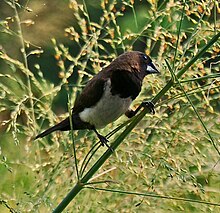Javan munia
Appearance
| Javan munia | |
|---|---|

| |
| Bogor, West Java, Indonesia. | |
| Scientific classification | |
| Domain: | Eukaryota |
| Kingdom: | Animalia |
| Phylum: | Chordata |
| Class: | Aves |
| Order: | Passeriformes |
| Family: | Estrildidae |
| Genus: | Lonchura |
| Species: | L. leucogastroides
|
| Binomial name | |
| Lonchura leucogastroides | |
The Javan munia (Lonchura leucogastroides) is a species of estrildid finch found in Southern Sumatra, Java, Bali and Lombok, Indonesia. Introduced in Singapore and S Malay Peninsula;[2] possibly introduced in Sumatra. It is found in subtropical/ tropical dry shrubland and grassland habitat. The status of the species is evaluated as Least Concern.
They are known to feed on algae,[3] and grasses. [4]
Origin
Origin and phylogeny has been obtained by Antonio Arnaiz-Villena et al..[5] Estrildinae may have originated in India and dispersed thereafter (towards Africa and Pacific Ocean habitats).
References
- ^ BirdLife International (2012). "Lonchura leucogastroides". IUCN Red List of Threatened Species. 2012. Retrieved 26 November 2013.
{{cite journal}}: Invalid|ref=harv(help) - ^ http://orientalbirdclub.org/wp-content/uploads/2013/01/Javan-Munia.pdf
- ^ Darjono; Dewi M Prawiradilaga & Sudaryanti. 1989. First Record of Algae in The Diet of Java Munia (Lonchura Leucogastroides) and Nutmeg Mannikin (Lonchura) in Indonesia. Ekologi Indonesia I (3) : 70-71.
- ^ Dr. C Hazzard. Personal observation
- ^ Arnaiz-Villena, A; Ruiz-del-Valle V; Gomez-Prieto P; Reguera R; Parga-Lozano C; Serrano-Vela I (2009). "Estrildinae Finches (Aves, Passeriformes) from Africa, South Asia and Australia: a Molecular Phylogeographic Study" (PDF). The Open Ornithology Journal. 2: 29–36. doi:10.2174/1874453200902010029.

